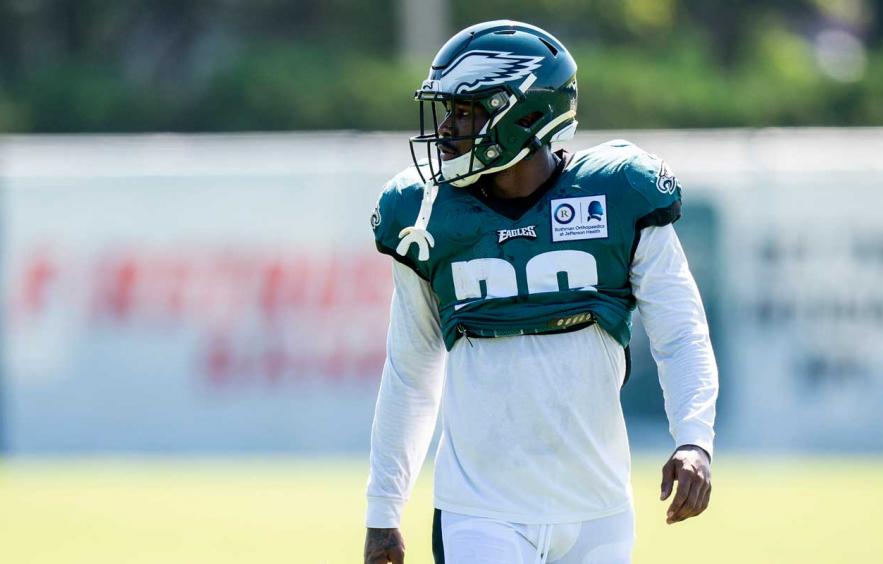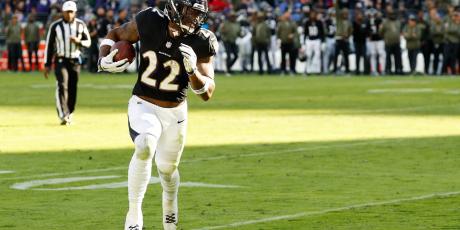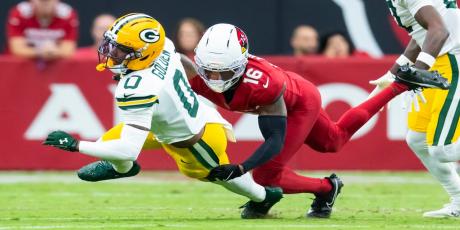Can Miles Sanders Fly High In 2022 Fantasy Football Leagues?

What a weird 2021 season it was for Miles Sanders. By now, we all know the basic, in-your-face stats: 163 touches, 912 total yards in 12 games, and zero touchdowns. Unfortunately, what tends to happen is we get so stuck on that zero touchdowns bit, we don’t see anything else. We need to remind ourselves that the outcome was an outlier and highly unlikely to repeat itself.
Over his first two seasons, Sanders scored a touchdown on 2.9% of his touches. Based on his career scoring average and his total touches in 2021, we should have expected him to score five touchdowns. That's 30 extra fantasy points right there. While that may not sound like a lot, we must remember that he only played 12 games and under 35% of the snaps in four others.
While the touchdowns are a concern, we cannot ignore just how incredibly effective Sanders was last year. He averaged 76 scrimmage yards per game despite missing ample time in several contests. That per-game average would have amounted to 1,292 yards across 17 games. With all this conflicting data, how do fantasy managers appropriately value his 2022 fantasy value?
Click here for more 2022 Player Profiles!
There’s More to Miles Sanders’ 2021 Season Than Meets the Eye
It was a bit of a bumpy road for the Eagles in 2021. Jalen Hurts was getting his first shot at being the starter and Nick Sirianni was in his first year as a head coach. They started off the year at 2-4, but in those first six games—prior to his ankle injury in Week 7 that would land him on IR for three weeks—Sanders was the unquestioned workhorse back in Philadelphia.
While everyone is quick to remember Boston Scott from last year, he was irrelevant when Sanders was healthy. In the first six weeks of the season, Sanders racked up 75 total touches. This was almost double what Kenneth Gainwell received (36) and it was astronomically more than Scott (2).
The snap-share from those first six weeks was even more favorable for Sanders. In fact, he had the eighth-highest snap share among all running backs.
A Miles Sanders Thread...
-Prior to his injuries, from Weeks 1-6, he had the 8th-highest snap share.
-7th-most routes run among RBs. 13th-most targets (60 target pace).
-66% route participation. Kamara finished the yr at 67%, 1st among RBs.
-85.7% catch rate.
1/ 🧵🧵🧵— Rob (@RobFFSlayer) June 28, 2022
While many will be quick to point out the number of red zone carries and touchdowns on the season for the Eagles, that doesn’t take into consideration the impact of Sanders’ injuries. The following table below is courtesy of Sports Info Solutions and shows all the red zone carries for the Eagles in the first six weeks of the season.
| Player | Attempts | Yards | Yards After Contact | TDs | Hit at Line | Stuffs |
|---|---|---|---|---|---|---|
| Jalen Hurts | 14 | 47 | 24 | 5 | 7 | 2 |
| Miles Sanders | 9 | -1 | 12 | 0 | 7 | 5 |
| Kenneth Gainwell | 3 | 16 | 2 | 2 | 0 | 0 |
While Hurts stole his fair share of red zone carries, that’s to be expected with a rushing quarterback of Hurts’ pedigree. It’s not ideal, but it’s hardly a death sentence either, especially considering Sanders’ price. The two bigger things to take note of are just how unlucky Sanders got on his carries and that Scott did not get a single carry inside the red zone. Sanders had nine attempts and -1 yards despite 12 yards after contact. This is despite the Eagles being ranked as the No. 1 offensive line going into 2022 and being a formidable unit in 2022.
Red zone carries are incredibly valuable for running backs for obvious reasons, but targets and involvement in the passing game are just as valuable. The perception is that Gainwell completely took over as the passing-down specialist for Philadelphia, but some of that is due to the late-season injuries Sanders had to deal with. The first six weeks when Sanders was fully healthy paint a different picture. In parenthesis, you’ll see Sanders’ rank among all running backs during that time.
| Player | Routes Run | Targets | Receptions | Yards | YAC | TDs |
|---|---|---|---|---|---|---|
| Miles Sanders | 105(11th) | 23 (11th) | 18 (11th) | 121 (20th) | 188 (8th) | 0 |
| Kenneth Gainwell | 70 | 23 | 15 | 123 | 120 | 0 |
| Boston Scott | 4 | 2 | 2 | 5 | 18 | 0 |
Data courtesy of SportsInfoSolutions
The first thing to take note of again is just how little Scott was used. He wasn’t a change-of-pace guy. He was a bench player and nothing more. While Sanders and Gainwell had the same number of targets, Sanders ran 35 more routes. Gainwell profiles as a pass-catching back and it’s likely he’s used like that this year. Fantasy managers should consider Nyheim Hines and J.D. McKissic-type players as comparisons for him. Meanwhile, Sanders' utilization in the first six weeks of the season continues to jump off the page.
It wasn’t just how Philly used him that should have fantasy managers intrigued by Sanders’ 2022 fantasy prospects, but how he played. Below is a table outlining Sanders' efficiency numbers in several advanced statistics and where they ranked among other running backs across the entire 2021 season.
| Player | YPA | YPA Rank | YAC/Att | YAC/Att Rank | EPA/A | EPA/A Rank | Positive % | Positive % Rank | Boom % | Boom % Rank |
|---|---|---|---|---|---|---|---|---|---|---|
| Miles Sanders | 5.5 | 2nd | 2.5 | 18th | .02 | 10th | 45.3% | 10th | 10.2 | 3rd |
Data courtesy of SportsInfoSolutions
On a per-touch basis, Sanders was one of the most efficient running backs in the NFL. Unfortunately, for Sanders and fantasy managers in 2021 after injuring his ankle in Week 6, he would play more than 50% of the snaps in just one more game the rest of the season. He left three games early but played well down the stretch.
During a four-game period between Weeks 11-15 (this includes a Week 12 contest where he played just 29.7% of the snaps), Sanders accumulated 446 total yards on 73 touches. He averaged 112 yards per game and 18 touches. We know he didn’t score, but he did have eight red zone touches during that time.
When you’re able to look a bit deeper at Sanders’ 2021 season, it’s not nearly as gloom-and-doom as it initially looks when you see his box score.
Should We Buy Into Miles Sanders?
Last year, the Eagles had 550 rushing attempts, the most in all of football. They also had just 494 pass attempts, which were the fewest in the NFL. With the acquisition of A.J. Brown, fantasy managers should expect the Eagles to pass more. Still, they were at their best when they focused their offense around their run game.
If we assume Philadelphia moves up 10 spots in both categories they’d finish with roughly 555 pass attempts and 470 rush attempts. Last year, the running backs had a 21.3% target share. With Brown in town, we can expect this number to decline some. If this decreases to 20%, the running backs would likely receive around 110 targets (105 last year). Below is a table of what that could look like in 2022 with their 2021 stats in parenthesis.
| Player | Targets | Target Share | Share of RB Targets |
|---|---|---|---|
| Miles Sanders | 38 (34) | 7.0% (6.8%) | 34.5% (32.4%) |
| Kenneth Gainwell | 61 (50) | 10.9% (10.1%) | 55.5% (47.6%) |
| Boston Scott | 11 (16) | 1.9% (3.2%) | 10% (15.2%) |
The table above is factoring in the growth of Gainwell’s role in the passing game. While Sanders’ numbers stay relatively the same, this is based on Sanders not missing time as he did in 2021 and the number of pass attempts increasing, so his role is actually decreasing, but the volume is staying relatively the same.
Throughout 2021, when Sanders was healthy, he was the primary ball carrier for the Eagles and we shouldn’t expect anything different this season. The other factor that will play a key role is Hurts’ utilization in the rushing game. Fantasy managers should be expecting him to be heavily involved.
| Player | Carries | Percentage of Team Carries |
|---|---|---|
| Miles Sanders | 212 | 45% |
| Jalen Hurts | 118 | 25% |
| Kenneth Gainwell | 98 | 21% |
| Boston Scott | 42 | 9% |
Hurts averaged 25% of the team carries last season. In Weeks 1–6, Sanders had 43.2% of the team carries, and in Weeks 11–15, Sanders had 41% of the team carries, which included a Week 12 contest where he played just 29.7% of the snaps.
Sanders has advocated for more touches and he’s in his contract year, so it’s possible the Eagles lean on him more this year, but the above projection is a modest projection based on last season’s utilization and the expectation that Gainwell is used more prominently in the passing game.
Based on Sanders’ career averages in regard to yards per carry, catch percentage, and yards per reception, he’d finish with 1,081 rushing yards, 27 receptions, and 224 receiving yards. With a modest six touchdown expectation, Sanders would finish with 180 half-PPR points. This would have resulted in an RB19 finish last year in overall scoring and RB26 in terms of PPG.
He’s currently being drafted as the RB26 on Underdog and here at 4for4, he’s ranked as the RB35. Fantasy managers shouldn’t shy away from Sanders at his RB26 price—at RB35 he becomes a steal. The Eagles were 12th in scoring last year and fantasy managers should expect the offense to be better this year with the arrival of Brown, a second year in Siranni’s system, and expected growth from Hurts.
There’s some upside for Sanders at his current price if Siranni chooses to listen to Sanders and afford him more touches in a contract year, which is certainly possible. He’s also in line for some significant touchdown regression. While Hurts proved to be an amazing red zone asset, only 11 quarterbacks have ever rushed for 10 touchdowns and only one (Cam Newton) has ever done it more than once and he never did it in back-to-back years. Any dip in rushing touchdowns from Hurts is likely to help Sanders.
The Bottom Line
- Sanders is entering a contract year, running behind a top-5 offensive line, playing on a top-12 scoring offense, and is coming off an incredibly efficient season.
- He will be the primary ball carrier for a team who appears poised to be one of the best rushing offenses in the NFL.
- Hurts will be a scoring nuisance for him, but fantasy managers should expect solid touchdown regression in 2022.
- Gainwell should continue to evolve in his role, which will likely reduce Sanders’ involvement in the passing game, which isn’t ideal.
- Sanders will make for a fine RB2 for fantasy managers this season and has top-20 potential if Siranni chooses to lean on him or if the touchdowns break his way.



















